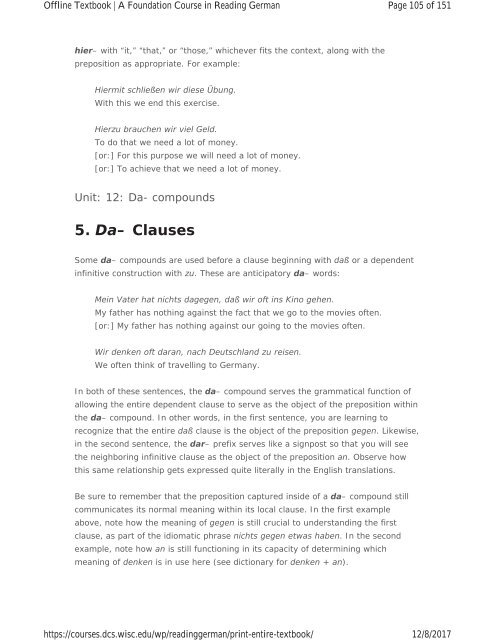A Foundation Course in Reading German, 2017a
A Foundation Course in Reading German, 2017a
A Foundation Course in Reading German, 2017a
Create successful ePaper yourself
Turn your PDF publications into a flip-book with our unique Google optimized e-Paper software.
Offl<strong>in</strong>e Textbook | A <strong>Foundation</strong> <strong>Course</strong> <strong>in</strong> Read<strong>in</strong>g <strong>German</strong><br />
https://courses.dcs.wisc.edu/wp/read<strong>in</strong>ggerman/pr<strong>in</strong>t-entire-textbook/<br />
Page 105 of 151<br />
12/8/2017<br />
hier– with “it,” “that,” or “those,” whichever fits the context, along with the<br />
preposition as appropriate. For example:<br />
Hiermit schließen wir diese Übung.<br />
With this we end this exercise.<br />
Hierzu brauchen wir viel Geld.<br />
To do that we need a lot of money.<br />
[or:] For this purpose we will need a lot of money.<br />
[or:] To achieve that we need a lot of money.<br />
Unit: 12: Da- compounds<br />
5. Da– Clauses<br />
Some da– compounds are used before a clause beg<strong>in</strong>n<strong>in</strong>g with daß or a dependent<br />
<strong>in</strong>f<strong>in</strong>itive construction with zu. These are anticipatory da– words:<br />
Me<strong>in</strong> Vater hat nichts dagegen, daß wir oft <strong>in</strong>s K<strong>in</strong>o gehen.<br />
My father has noth<strong>in</strong>g aga<strong>in</strong>st the fact that we go to the movies often.<br />
[or:] My father has noth<strong>in</strong>g aga<strong>in</strong>st our go<strong>in</strong>g to the movies often.<br />
Wir denken oft daran, nach Deutschland zu reisen.<br />
We often th<strong>in</strong>k of travell<strong>in</strong>g to <strong>German</strong>y.<br />
In both of these sentences, the da– compound serves the grammatical function of<br />
allow<strong>in</strong>g the entire dependent clause to serve as the object of the preposition with<strong>in</strong><br />
the da– compound. In other words, <strong>in</strong> the first sentence, you are learn<strong>in</strong>g to<br />
recognize that the entire daß clause is the object of the preposition gegen. Likewise,<br />
<strong>in</strong> the second sentence, the dar– prefix serves like a signpost so that you will see<br />
the neighbor<strong>in</strong>g <strong>in</strong>f<strong>in</strong>itive clause as the object of the preposition an. Observe how<br />
this same relationship gets expressed quite literally <strong>in</strong> the English translations.<br />
Be sure to remember that the preposition captured <strong>in</strong>side of a da– compound still<br />
communicates its normal mean<strong>in</strong>g with<strong>in</strong> its local clause. In the first example<br />
above, note how the mean<strong>in</strong>g of gegen is still crucial to understand<strong>in</strong>g the first<br />
clause, as part of the idiomatic phrase nichts gegen etwas haben. In the second<br />
example, note how an is still function<strong>in</strong>g <strong>in</strong> its capacity of determ<strong>in</strong><strong>in</strong>g which<br />
mean<strong>in</strong>g of denken is <strong>in</strong> use here (see dictionary for denken + an).


















